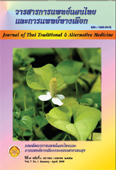Chronic Toxicity of Thunbergia laurifolia Lindl. Extract
Main Article Content
Abstract
Thunbergia laurifolia Lindl., or rang chuet, is a medicinal plant that is used for the treatment of poisoning
with toxic substances. However, the toxicological data for this plant are not complete. Therefore, a chronic
toxicity study of rang chuet extract (TLE) was undertaken in six groups of Wistar rats. The control group
(group 1) was given 10 ml/kg of distilled water per day orally. The five experimental groups (groups 2-6) were
orally administered TLE at doses of 20, 200, 1,000, 2,000 and 2,000 mg/kg/day for six months, respectively,
which were equivalent to 1, 10, 50, and 100 times the therapeutic dose. Group 6 (2000R) was added to the
study recovery group after 14 days of TLE discontinuation. The results revealed that TLE did not affect the
body weight, food consumption, behavior or general health of the animals. TLE did not produce cumulative
toxic signs and fatal effects. Male rats receiving TLE at the dose of 2,000 mg/kg/day and the 2000R group had
a significant decrease in RBCs, including a significant difference in red cell indices, but these were within the
normal range. Female rats receiving TLE at doses of 1,000 and 2,000 mg/kg/day showed significant increases
in WBCs. Both sexes of the rats treated with 2,000 mg/kg of TLE had a significant increase in bilirubin levels;
however, these were within the normal range. TLE did not produce any histological alterations of the visceral
organs in any group of rats. However, the results suggest that hematological and clinical chemistry values
should be monitored during prolonged use of TLE.
Article Details
References
2. Hutchinson J. The family of flowering plants. Oxford: The ClarendonPress; 1973. p. 609-10.
3. The Forest Herbarium Royal Forest Department. Thai Plant Names(Tem Smitinand Revised Edition 2001). Bangkok: Phachachon Press;2001. p. 526.
4. Perry LM, Metzger J. Medicinal plants of East and Southeast Asia.Cambridge: MIT Press; 1980. p. 6.
5. Association of Thai Traditional Medicine School. Pramuan Supakun Yathai Part 3. Bangkok: Ampolpittaya Printing; 1973. p. 110. (in Thai)
6. Tejasen P, Thongtharb C. Experimental using Thunbergia laurifolia as antidote for insecticide poisoning. Chiang Mai Medical Bulletin1980;19:105-14. (in Thai)
7. Dunkhoom, P. Effectiveness of Thunbergiaceae on reducing insecticide residue level in blood circulation of agriculturists. FDA Journal 2001;8:42-9. (in Thai)
8. Pramyothin P, Chirdchupunsare H, Rungsipipat A, Chaichantipyuth C.Hepatoprotective activity of Thunbergia Laurifolia Linn extract in ratstreated with ethanol: in vitro and in vivo studies. J Ethnopharmacol 2005;102:408-11.
9. Visitpongpant W , Ruamgyuthikarn V, Rujjanavej C, Pantong A ,Vinijkhetkamnuan, Lertprasertsuk N. Testing of toxicity of Thunbergia laurifolia Linn. abstract in mice. J Med Hearb 2003;10:23-36.
10. Gad SC. The rat: Pathology. In : Gad SC, Chengellis CP, editors. Animal Models in Toxicology. New York: Marcel Dekker; 1982. p.78-81.
11. Campbell TW. Mammalian hematology: Laboratory animals and miscellaneous species. In: Troy DB, editor. Veterinary hematology and clinical chemistry. Baltimore: Lippincott, Williams and Wilkins;2004. p. 215.
12. Pimainog Y, Yothinarak A, Jornrakate P. Reference ranges for hematological and clinical chemistry values in Wistar rats. Bulletin of the Department of Medical Sciences 2003;45:27-36. (in Thai)
13. Techakitiroj V. The effect of rang chute (Thunbergia laurifora Linn.) extract on rat splenocytes by Fourier Tranform Infrared Spectroscopy.
Thesis for Masterûs Degree (Pharmacology). Chulalongkorn University.2004.


